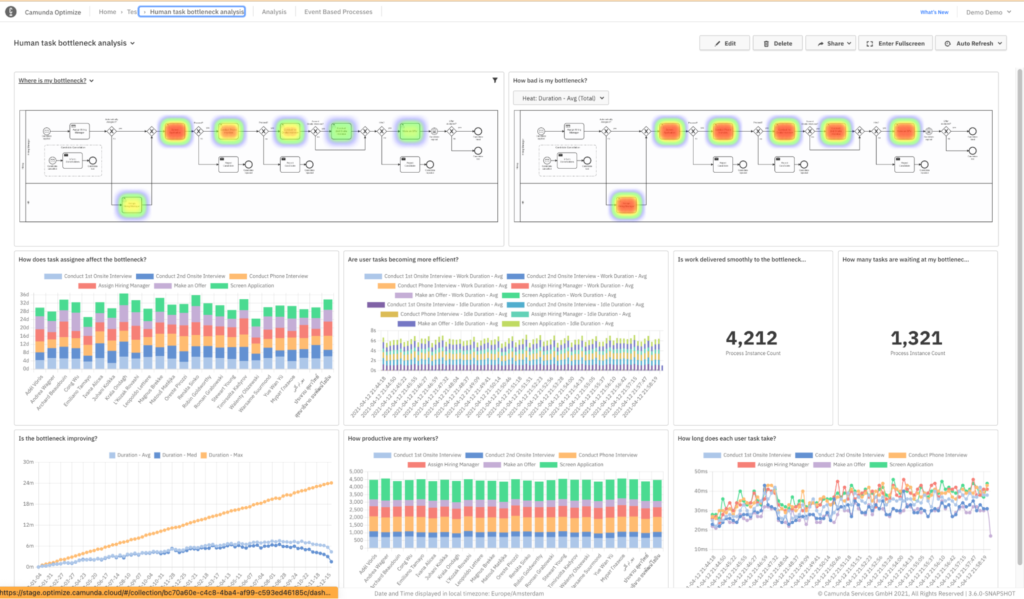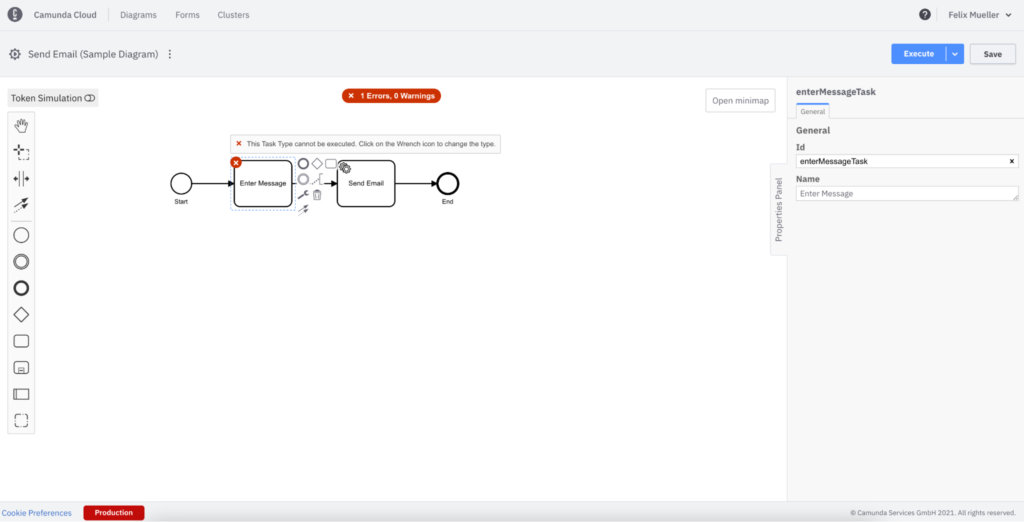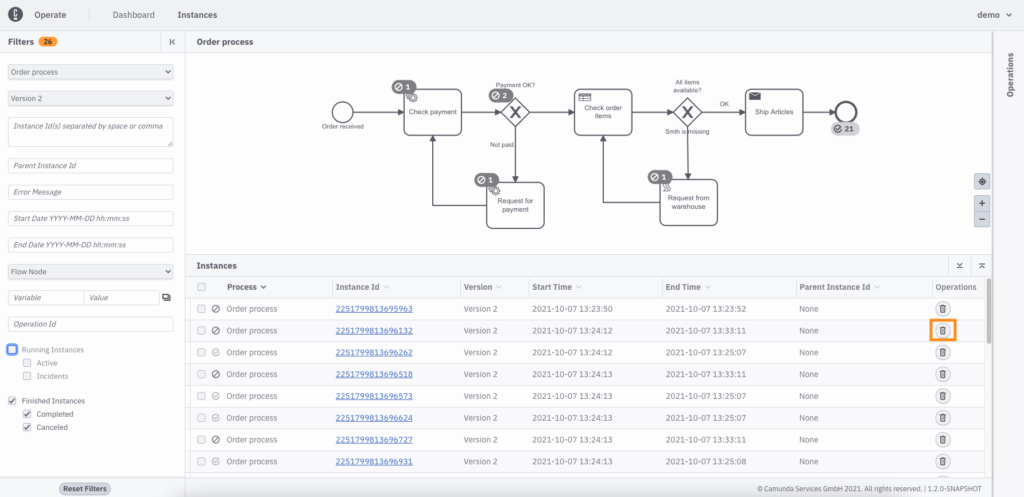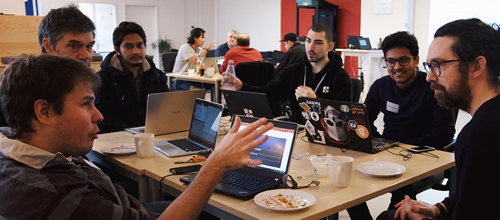A key component to digital transformation is delivering a delightful customer experience. Today, your customers expect speed and accuracy at every touch-point. Ensuring your process automation is fast, scalable and resilient is the difference between the engaging experience we strive for and disaster. Camunda Cloud’s modern architecture brings peace of mind to organizations by combining world class process automation with the speed, scale, security and redundancy that only a modern cloud architecture can provide.
Camunda Cloud’s latest release brings enhanced enterprise capabilities, open architecture and real-time monitoring ensuring an exceptional user experience for your customers.
Highlights from the Camunda Cloud 1.2.0 release include:
- Optimize – intelligent reporting and monitoring that allow teams to quickly identify bottlenecks keeping customer experiences fast and engaging.
- Enhanced enterprise capabilities such as identity and access management components, improved failover handling, and support for clusters in North America enable improved speed, scale, security and redundancy.
- Our commitment to open architecture extends to Camunda Cloud with an enhanced Tasklist API that enables you to create custom experiences for your human workflows directly in your own apps.
Camunda Cloud 1.2 includes:
- Modeler 4.11
- Zeebe 1.2.0
- Operate 1.2.0
- Tasklist 1.2.0
- Optimize 3.6.0
Process Reporting and Monitoring with Optimize
Optimize brings near real-time visibility to your automated processes, allowing teams to quickly identify process bottlenecks before they negatively impact your business. Optimize lets users quickly create reports and dashboards directly within the Camunda Cloud user interface.

After a three-month beta period, we are making Optimize generally available for Camunda Cloud SaaS with this release.
Read more about Optimize in our Optimize 3.6.0 release blogpost.
Enhanced Tasklist API for Custom Applications
Camunda Cloud 1.2.0 brings new enhancements to the Tasklist GraphQL API. The changes are designed to easily integrate Tasklist with your own custom application across any screen including web, mobile and tablets.
The main changes to the API include:
- Claim Task now allows for a custom assignee to be passed
- Any task can be completed through the API (before only tasks claimed by the same user could be completed)
- User Task object now has additional property and the API allows for tasks to be filtered by taskDefinitionId
Alongside the improvements in the Tasklist API, we have published a new tutorial in our documentation which shows you how to build your own Tasklist based on our APIs. You can find an example in this repository.
Improved Resiliency and Performance
With Camunda Cloud 1.2.0, we are doubling down on resiliency and performance. First, we’ve enhanced the failover handling in Zeebe. Next, we have introduced a new region in North America. This combination of enhancements ensures your business critical processes have low latency and maximum uptime.
Improved failover handling boosts recovery speed by 1200X
Zeebe 1.2.0 enables followers to process replicated log entries and build up a local state of the system. Before this, the state was only built on the leaders and in a failover situation the follower was required to replay the entries of the logstream beginning from the last snapshot to build up the state.
By allowing followers to build up the state already during the replication, a failover can be resolved faster as the new elected leader can immediately pick up and continue the work with the already present state. For technical details please see the technical concept of this feature.
In the first benchmarks of this feature, the lead change and recovery showed a significant reduction in failover time. In an experiment with a high load of running and completing process instances, the recovery time went from around two minutes with Zeebe 1.1 to less than 100 milliseconds with Zeebe 1.2.
New region in North America
With this Camunda Cloud release, we have introduced our first officially supported region in North America for our managed service: US East.
Depending on where your infrastructure is located, creating a Camunda Cloud cluster in the US East region can lead to significant reduction in latency.
We plan to add additional regions to our Cloud offering in the coming months. Feel free to reach out and give us feedback if there is a specific region you would like us to add.
New Identity and Access Management Component
We’ve introduced a new component for Camunda Cloud Self-Managed called Identify and Access Management (IAM).
IAM is the component within the Camunda Cloud stack that is responsible for authentication and authorization. IAM allows you to manage users, roles and permissions.
In IAM, users can be managed directly in the user interface or automatically via LDAP and Active Directory.
Besides users, IAM allows you to manage roles that can be assigned to users. Each role can consist of one or more permissions. The first permissions that we introduce in Camunda Cloud 1.2 are:
- Operate full access
- Operate read-only access
- Tasklist full access
- Tasklist read-only access
Read more in our documentation on IAM.
Improved BPMN and Process Design Capabilities
At the core of Camunda Cloud is process automation and therefore we are extending BPMN modeling support as well as adding powerful operational capabilities.
Support for message throw and none-intermediate events
With this release we are adding support for additional BPMN symbols, which means you have complete coverage for all message events that the BPMN standard offers. Updated support includes:
- Message Throw Intermediate Event
- Message Throw End Event
- None Intermediate Event
Both message events can be implemented using job workers with the help of Camunda Cloud clients. This allows you to visualize certain patterns even better.
The None Intermediate Event is especially useful for collaborating with other stakeholders to visualize important milestones within your process. Optimize has also been updated to allow for efficient filtering of process data.
You can find the current coverage in our documentation.
Improved drill-down and navigation in Operate
In Operate, we have introduced an improved call-activity drilldown to automatically generate a breadcrumb below the main navigation when you drill into call activities. This helps you to easily navigate from subprocess instances to parent process instances.

Assisted process modeling in Console Modeler
In our Console Modeler, we have introduced a new mechanism for validating process diagrams before deployment. This functionality helps guide users when creating new diagrams to ensure they can become executable.
- Process validation before deployment to save time and frustration as you build your models
- Documentation links in the properties panel guides your eyes to the properties that you have set

Deleting process instances in Tasklist and Operate
We’ve introduced a new capability in Operate which allows you to delete finished instances directly from the user interface by clicking on the shown icon next to a process instance.

This operation can be especially useful if you store certain information in your process variables that are attached to the process instance which you are not allowed to store anymore (e.g. due to GDPR reasons).
The same operation is also possible via the Tasklist GraphQL API – see here in our documentation.
How to Get It
For Camunda Cloud SaaS customers, you will have the ability to seamlessly update at your own discretion via Console starting on Oct. 12, 2021. SaaS trials with existing clusters will remain on the older versions, while new clusters will automatically be created on Camunda Cloud 1.2.0. Lastly, our self-managed customers can find the new releases for Zeebe Engine, Operate, Tasklist and IAM published on GitHub, and read more via our update guide.


